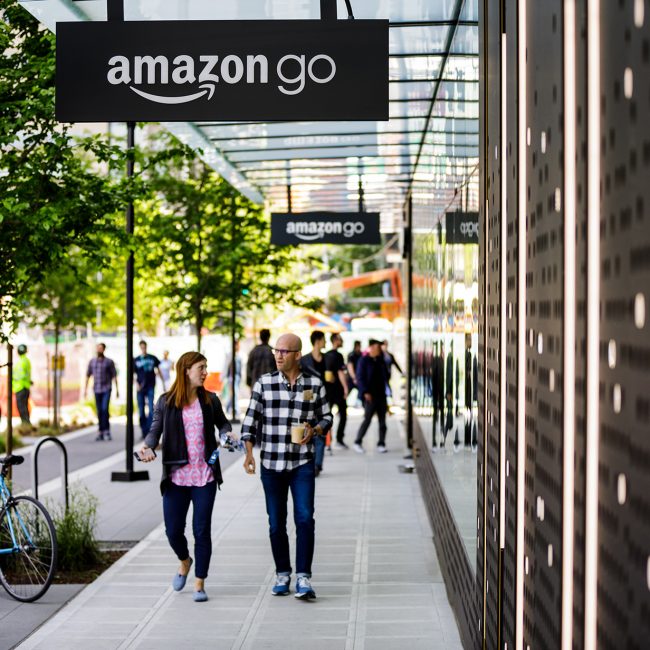
- 2 Min Read / Blog / 3.2.2020

It’s just now turning to spring temperatures in Chicago, and the streets outside our home office at 150 N Michigan Avenue are already bustling with tourists and avid shoppers enjoying one of the more iconic shopping destinations around. Soon, it will be nearly impossible to navigate the teeming hordes of shoppers along Michigan Avenue and State Street. For me, one reality about the shopping experience is never more apparent than it is during a nice summer day in Chicago—digital commerce can’t compete with physical retail.
I know that statement will make my digital commerce brethren bristle, but the numbers don’t lie. E-commerce revenue is still a fraction of what’s spent by consumers every year in actual stores. Some even question digital’s overall influence in the purchasing process. Forrester, for example, estimated that roughly 36% of all retail purchases in 2018 were influenced by digital technology.
A heightened investment in digital can play two crucial roles for brick-and-mortar retailers: preparing them for a future without stores, and extending the life and influence of their physical locations.
Given the pervasiveness of smartphones, targeted advertising, and social media—to name a few sources—that number feels wildly low. Because of that, it can be tempting for retailers—the large and small alike—to allocate mere fractional portions of their annual marketing budgets to digital, opting instead to maintain a strategic focus on the brick-and-mortar tactics and traditional advertising methods that have kept foot traffic in their stores for years. We know with absolute certainty that the trend toward digital will continue, and brick-and-mortar retail is not exactly safe from disruption.
I’d argue that a heightened investment in digital can play two crucial roles for brick-and-mortar retailers: preparing them for a future without stores, and extending the life and influence of their physical locations.
For many, the traditional brick-and-mortar storefront has given way to Amazon and Google Search. Nearly half of digital shoppers consult Amazon when searching for products online, while around 1 in 3 do the same with Google, according to eMarketer. This shouldn’t come as much of a surprise, since Amazon is responsible for nearly half of all e-commerce sales. While this number still pales in comparison with total retail sales in any given year, the trend should be worrisome to slow-movers because of the way digital marketplaces are changing the conversation about shopping.
Regardless of where you intend to make a purchase, Amazon, for example, provides you with the following information on just about any product you might be researching:
If your entire shopping life had been spent using Amazon, your first trip to a physical retail store might feel a bit overwhelming and, likely, wildly unhelpful. But, this is how younger generations are being trained to approach the shopping experience. There is no more convenient place to research and purchase most products today than Amazon. The reason for this isn’t because they control such a large share of the market—it’s because the Amazon user experience is designed to be the most convenient, quick, and simple shopping experience imaginable.
Make no mistake—the retail future without storefronts is already here. Brands that deny this reality risk losing huge market share in the years to come.
Brick-and-mortar retail isn’t going away anytime soon, however. In fact, digital-first consumer brands like Warby Parker, Bonobos, and even Amazon are seeking to prove that investment in physical retail space does pay off. That said, if you’ve ever walked into one of these brands’ stores, you’ll know that the experience is markedly different from the average retailer. Inventory is kept to a minimum, and customers ultimately purchase products that they do not carry out of the store. The experience of the stores themselves is tailored more toward customer enjoyment than it is revenue generation.
The latest example of this experience-first trend can be seen in Capital One’s construction of its café concept—a coffee shop where you can open a bank account or apply for a credit card, among other things.
If you look even deeper, it becomes clear that the storefront of the future is significantly—and in some cases entirely—powered by digital technology. It’s nearly impossible to walk out of a Starbucks without using its loyalty app. The second-hand goods market is exploding, thanks to Craigslist, eBay, NextDoor, OfferUp, and countless other marketplaces, online and on our phones. You can’t actually even shop at Amazon Go without the Amazon Go app.
The world’s most powerful physical and digital brands invest in syncing the two experiences so that customers feel they must use one to appropriately enjoy the other. And, when the two work in tandem, the brand’s overall customer experience becomes exponentially more valuable than that of its nearest competitors’.
If you’ve made it this far, I can only assume you’re looking for specific advice—a list of steps—for how your brand can take that milquetoast digital experience you’ve already invested in and help it drive the results you’d hoped it would all those years ago. I have good news and bad news.
The bad news is that this post couldn’t possibly give you the keys to digital success. Great digital experiences that create real ROI are built over time and rely on a solid strategy, user understanding, and personalized UX. This means the answer varies significantly from one user set to another. The good news is that my colleagues and I at Punchkick are skilled and passionate about creating digital products and e-commerce platforms on top of that user-focused foundation.
If this sounds like you, we’d love to talk about how Punchkick can elevate your retail brand to the next level.